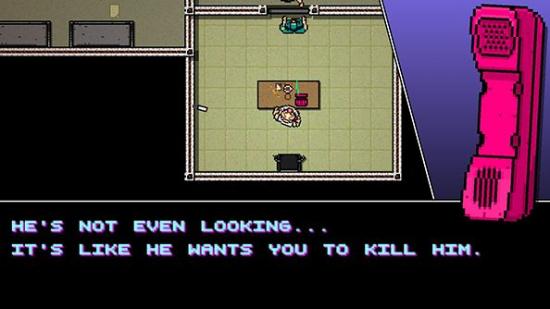Hotline Miami is the first time I can think of a game’s violence’s made me say “Holy shit” out loud.
One of the new enemies, a police commando, combat rolls around the level in his body armour, pointing two Magnum revolvers ahead of him wherever he goes. You have to shoot him to the ground with gun fire and then execute him where he lies – you pull and tear at his head, listening to the ligaments pop before the skin rips and the head comes free, trailing about a foot of spinal cord.
It’s more bloody, more ambitious, and more experimental than its predecessor. But is it any good?
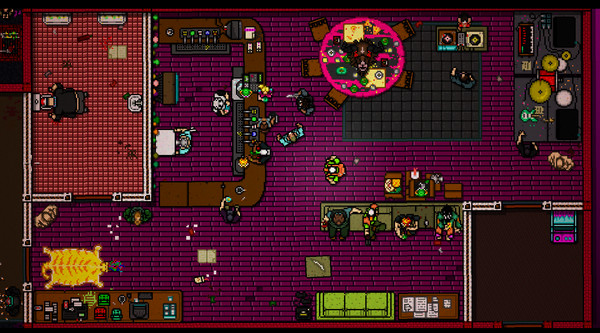
The core mechanics of Hotline Miami 2 are identical to its predecessor. Looking a little like the original GTA, Hotline’s a top-down shooter which gives you a simple goal: kill everybody. Most levels start with you going into the ground floor of a building, fighting your way to the top floor, and ends with you walking back to your car, admiring the carnage you left in your wake.
While the task is simple, it is not easy.
Everyone you face will be armed – from a lead pipe up to an assault rifle, with blades, axes, shotguns, and pistols in between. All it takes is one hit for you to die. Death means restarting the floor. There’s a danger of wearing out your ‘r’ key you’ll be restarting so often.
You can pick up weapons with a right click, use them with a left, and throw them with another click of the right mouse button. This simple set up will see you kick in room’s door, punching a man to the floor, picking up the knife he dropped, spinning on the spot to slash the man with a bat coming up behind you, and turning back to throw the knife into the head of the man with a shotgun who’s just coming round the corner, back from patrol. The action is fast, violent, and, when you pull it off successfully, immensely satisfying.
This will all sound familiar to fans of the first game. Hotline Miami 2’s core is nearly identical to its predecessor, it even reuses a lot of the art and sound effects.
This isn’t to say all of Hotline Miami 2’s rehashed, more that it’s enhanced. Dennation’s added new artwork, along with a stack of new weapons, animations, and characters. The levels are larger and support many more enemies than the first game. It’s also far gorier, with bodies bursting and breaking under your attacks. An enemy gut shot with a shotgun at close range will be disemboweled by the blast, spreading intestines across the floor. You can decapitate enemies, leaving the head as a 3D object to kick around the level.
The increased level size and enemy count has made the game much more difficult. From the very first level some enemies carry shotguns and uzis. The longer corridors and larger rooms makes it a lot harder to reach the gun-toting foes without being shot, forcing you to play more cautiously. The further you get into Hotline’s story the more of the enemies you face are armed with guns.
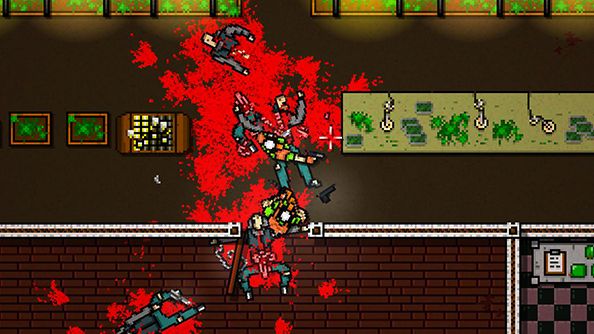
The larger levels introduce another difficulty – you can’t see the people who are shooting at you. Even by pressing shift to stretch your vision you’ll often find yourself unable to see the end of a corridor. As you walk up the corridor blasts of shotgun and rifle fire cut you down. While you will eventually learn where the enemy guards are posted and fire a couple of pre-emptive shots their way, it’s frustrating to have your spree cut short by someone who’s just out of sight.
The excess of guns meant I rarely relied on melee weapons, instead dropping them in favour of a firearm every time I could. They’re just far more effective against a ranged enemy, considering the risk of trying to close the distance against someone who can kill you with a single shot.
Hotline Miami 2’s fractured story picks up events after the first game ended, but it also tells the story of what came before Jacket’s spree against the Russian mob and explains what other people were doing during his rampage. Outside of the two game’s chronologies is a slasher movie, Midnight Animal, where you play the lead, a psycopath in a pig mask whose performance is a little too convincing.
All told, you’ll play more than ten different characters, spanning nearly a decade of violence, hopping backwards and forwards through time across more than 20 levels.
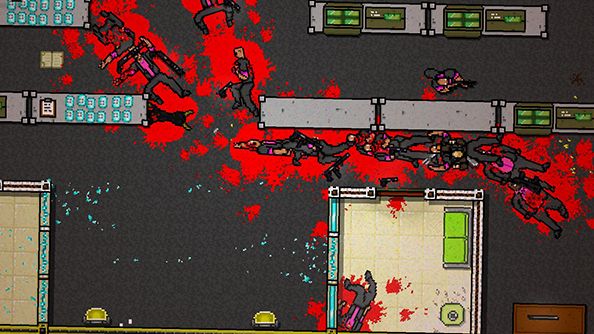
The characters don’t just look different from one another, they each play a slightly different variant of the core game. One character, a spec ops soldier fighting in a secret jungle war before the events of the first game, isn’t able to pick up weapons and must, instead, find ammo in the enemy camps he’s assaulting. Jake, a snake-mask wearing Russophobe, whose corpse you find in a mob safe house in the first game, can choose from a set of masks before every level, each granting him different perks – lethal throws, the ability to take two shots before dying, etc. Evan, a journalist investigating Jacket’s killing spree, is able to complete levels non-lethally, leaving his enemies writhing in pain instead of in a puddle of gore. However, if you do kill people, Evan goes into a super-powered rage where he can take more damage and move faster.
It encourages you to approach of each these characters’ levels slightly differently, embracing new tactics.
However, some of these characters feel like rough experiments, and don’t wholly work. The Swans, for instance, Alex and Ash, are a brother and sister who you control simultaneously. Alex’s armed with a chainsaw which you can swing with a left mouse click, Ash picks up guns from fallen enemies and can fire with a right mouse click. You move with Alex and Ash follows, or at least tries to. Ash is always getting stuck on scenery and must teleport to catch up with you. Ash’s other problem is getting him to stand where he’s supposed to. Because you don’t have direct control, lining him up in front of a door so he can shoot the enemies in the next room is a challenge; more often than not he’d shoot into the door frame or the wall next to the door. I found the best way to use the pair was to stand Alex next to the door and have Ash fire a shot into the wall to draw in all the nearby enemies. I’d carve them up with the chainsaw as they came running through the door. It cleared the levels but it felt like I was exploiting the dim AI instead of playing properly.
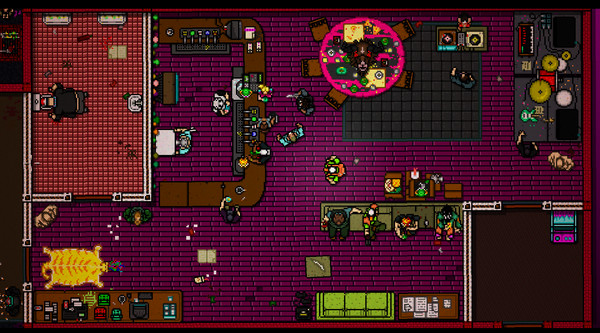
Mark the bear is similarly flawed. He starts each level with a pair of submachine guns. If you could the right mouse button then he begins to arc his arms out to the side, letting you fire to your sides instead of straight ahead. In the trailer Mark runs down a corridor shooting the guards stood in cover at both arms of a T-junction. I never found an instance when I could play like that, though. So, again, it looks good but it doesn’t add much to the game.
The problem’s worse than a couple of shonky characters. Switching between them ruins the game’s flow. You’ll have a wonderfully fast-paced game as the melee-only Tony the Tiger before switching to the special forces character. Because the soldier can’t pick up weapons you have to creep through levels, trying to hide behind corners and knife passing enemies, conserving ammo for the boss characters. Any momentum you picked up as Tony is lost, the excitement turns into tedium.
Frustratingly, some problems from the first game remain, too. Doors still confuse the AI: they’ll sometimes get trapped in the threshold where they’ll vibrate for a few seconds before popping free. It’s still too easy to step into a door that’s already swinging and, instead of swinging open to let you fire into the room, the door passes into you and blocks all your bullets, alerting the AI to your presence but not harming them.
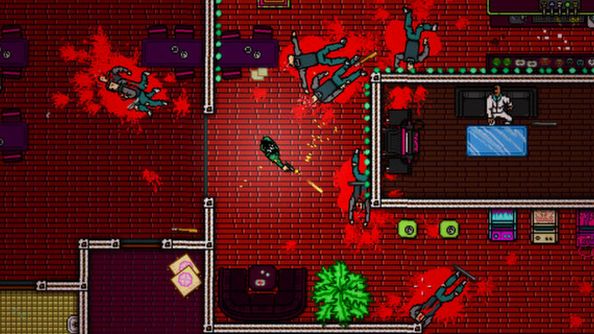
The AI still pays no attention to the world around them – happily walking over the corpses of their comrades without taking notice, rushing towards the sounds of gunshots without being cautious, and going back to their old patrols as soon as they lose sight of you.
There are certainly times when everything comes together, when you lay out a plan for a room, working out your exact movements before kicking in the door, enacting each attack perfectly, turning gang of enemies into bloody corpses in the space of seconds but they come too rarely, often prevented by the game’s baggage.
I wanted to like Hotline Miami 2. I adored the first game, and everything the trailers promised – new weapons, enemies, mechanics, and violence, oodles of violence – looked excellent. However, it’s just not as enjoyable. The first game felt like a focussed blast of adrenaline. Hotline Miami 2’s always stopping and starting, its new characters feel rough and buggy, and the new reliance on guns restricts how you can approach combat.
